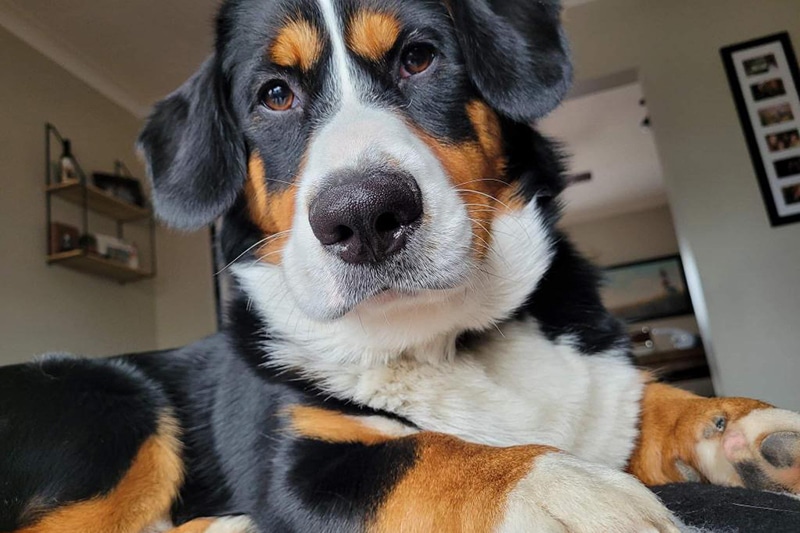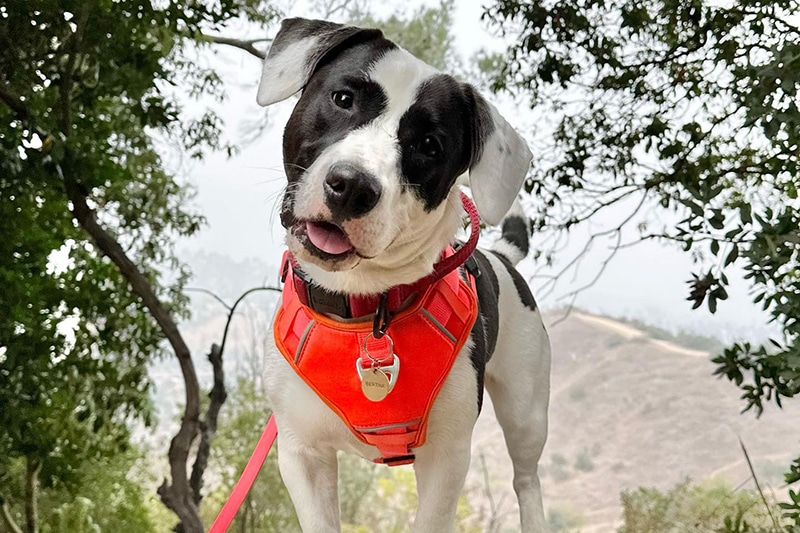The Corgi Tibetan Mastiff mix is an unusual and rare mixed-breed dog created by breeding a Pembroke Welsh Corgi with a Tibetan Mastiff. This curious mixed-breed has only been around for less than two decades and is fast becoming a popular option for those seeking a fluffy, beloved family pet.
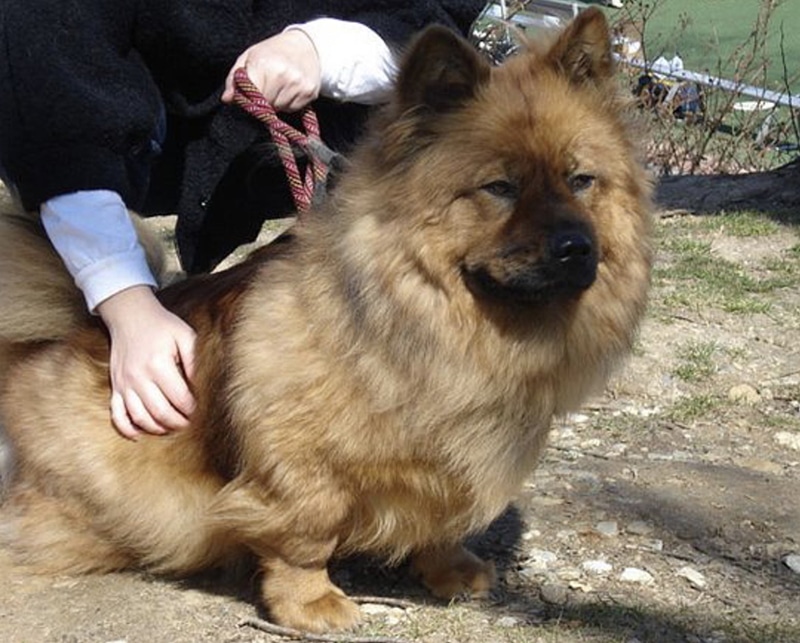
The Corgi Tibetan Mastiff pulls together the friendly, good-natured Pembroke Welsh Corgi and the fur-bomb behemoth Tibetan Mastiff to produce a loving, loyal and active breed with high energy levels, a love of people, and the outdoors.
The Tibetan Corgi will live its best life around a family, with a house & yard where it can get proper exercise. The Tibetan Mastiff Corgi will do much better on a farm than in the city and isn’t well-suited for apartments or the elderly, due to their size and exercise requirements.
Corgi Tibetan Mastiff Mix – At a Glance
| Weight: | 25 – 50 pounds |
| Height: | 12 – 25 inches |
| Lifespan: | 10 – 14 years |
| Coat Colors: | Tan, white, black, brown, or a combination thereof |
| Temperament: | Friendly, active, energetic, loyal, loving |
| Most Suitable For: | Active families with or without children, active single individuals |
What Does a Corgi Tibetan Mastiff Mix Look Like?
A Corgi Tibetan Mastiff mix will adopt its looks from both parent breeds. Taking from the Welsh Corgi genes, your Corgi Tibetan Mastiff mix will likely have short legs and a shorter tail that may hang down rather than be upright, like a traditional Tibetan Mastiff.
You can expect your Corgi Tibetan Mastiff mix to mostly look like a Tibetan Mastiff on the surface – that is, a huge, fluffy coat. Your Corgi Tibetan Mastiff mix will likely have a double coat, as both parent breeds are double-coated dogs. This double coat will require daily brushing in shedding season, which happens moderately throughout the year, with a ‘blowout’ occurring in the Spring and Fall.
Its exact weight and height is difficult to predict, as Tibetan Mastiffs are a wildly different size to the Pembroke Welsh Corgi. Because of this, you can expect a wide variety of average sizes.
Are you looking for a way to treat your furry friend? Sign up for our newsletter for a chance to win a free month of Barkbox!
The History of the Corgi Tibetan Mastiff Mix
Unfortunately, the history of the Corgi-Tibetan Mastiff mix is almost non-existent. As a designer breed, they’re a relatively new mixture. Most designer dogs were created during the last thirty years as crossbreeding became more popular throughout the United States.
The Tibetan Mastiff Corgi mix was likely created during the 1990s or early 2000s, combining the physical beauty of the Tibetan Mastiff with the friendly, ever-pleasant nature of the Pembroke Welsh Corgi. Designer dog breeders seek to build pets by combining the best parts of each parent breed.
This is mostly done with some of the most popular breeds, which include the Mastiff Corgi mix.
The History of the Tibetan Mastiff
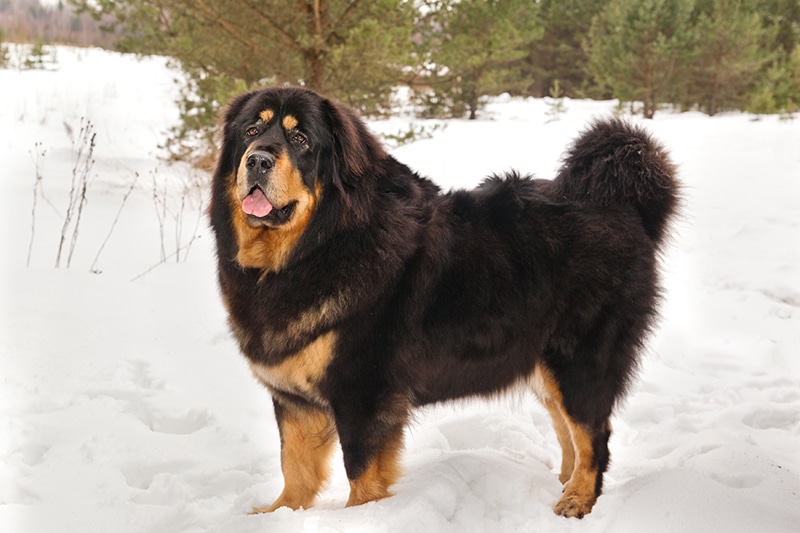
The Tibetan Mastiff hails from Tibet, a glorious mountain region in Asia. The Tibetan Mastiff was bred as a flock guardian by Tibetan monks, but quickly became monastery guardians as well, safeguarding the monks from snow leopards, wolves and bears.
During the early 20th century, George V of England (then Prince of Wales) brought Tibetan Mastiffs to England and they were originally shown in 1906 in various dog shows. The European history of the Tibetan Mastiff is somewhat spotty – the breed’s popularity has steadily increased and decreased over the decades since the early 20th century.
One of the reasons for the slow popularity growth is the cost of Tibetan Mastiff puppies from regulated dog breeders – these can range between $1500 and $5000 per pup! This exorbitant cost has largely kept the Tibetan Mastiff an anomaly in Europe and the United States.
How Popular Are Tibetan Mastiffs in the United States?
Despite their high cost, the breed is relatively popular in the United States. The American Kennel Club recognized the Tibetan Mastiff as the AKC’s 155th breed in 2006. They ranked as the 147th most popular dog in the United States in 2021.
Not well-suited for urban environments, the Tibetan Mastiff mostly finds a home on many American farms and in the rural countryside where they can run and roam (nearly) as freely as in the mountains of Tibet.
Who Are Tibetan Mastiffs a Good Dog For?
Because of their sheer size, Tibetan Mastiffs are only good dogs for those with enough space to house them and who can handle their physical strength and size. Weighing over 100 pounds and standing more than two feet tall, Tibetan Mastiffs are fantastic family dogs, though they can exhibit a prey drive due to their history – so if you have other pets – consider a different breed.
How Did Tibetan Mastiffs Come About?
The exact history of this Tibetan behemoth is unknown. However, they were initially bred by Tibetan monks to guard their monasteries from animals and human threats. They are closely related to the Great Pyrenees, Rottweiler, Bernese Mountain Dogs, and the Saint Bernard.
When Did We First Cross-Breed The Tibetan Mastiff?
The Tibetan Mastiff’s crossbreeding history is somewhat lost to the sands of time, due to the obscurity of the breed’s origins and history. However, we do know that the Tibetan Mastiff has steadily been growing in popularity since the 1980s, so it’s no wonder that these long-haired breeds are popular crossbreed parents.
A few of the more common Tibetan Mastiff crosses include:
- Tibetan Mastiff Saint Bernard Mix (Saint Bermastiff)
- Tibetan Mastiff Siberian Husky Mix (Tibetan Husky)
- Tibetan Mastiff Poodle Mix (Mastipoo)
- Tibetan Mastiff German Shepherd Mix (Tibetan Shepherd)
The History of the Corgi
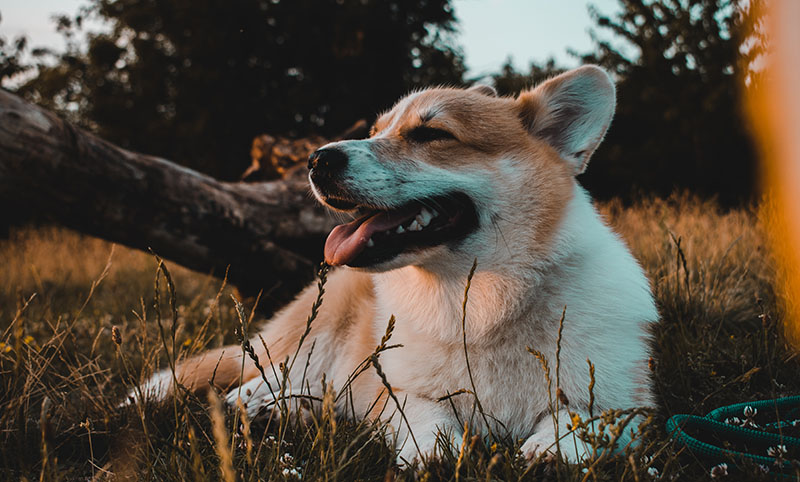
The Welsh Corgi was originally brought to Wales by Flemish weavers, who migrated from Flanders (modern-day Belgium) to Wales in the early 12th century. It is thought that the Flemish and their herding dogs first arrived in 1107 A.D. They settled in an area now known as Pembrokeshire – hence the name “Pembroke Welsh Corgi.” Originally raised as a herding breed, Welsh Corgis aided their Flemish masters in herding sheep and other cattle by using their small size to nip at the heels of cattle.
As centuries passed, the Pembroke Welsh Corgi would be replaced as a herding breed by other dogs, such as Border Collies. Despite this, the Pembroke Welsh Corgi would fast become a family pet, even making their way into the Royal Household and becoming the favorite dogs of Queen Elizabeth II.
Her Majesty owned more than thirty Corgis during her lifetime, beginning her Corgi collection when she was 18. Corgis are beloved by common folk and royalty for their calm, loving nature and laissez-faire approach to life.
The Pembroke Welsh Corgi has a cousin – the Cardigan Welsh Corgi – developed in Cardigan, Carmarthenshire, Wales. Though Cardigan Welsh Corgis are physically very similar to their Pembroke Welsh cousins, they are nowhere near as popular.
How Popular Are Corgis in the United States?
The Pembroke Welsh Corgi first arrived in the United States in 1934. The American Kennel Club first recognized the Pembroke Welsh Corgi in 1935, along with the Cardigan Welsh Corgi. Before 1935, the AKC had classified the Pembroke Welsh and Cardigan Welsh as the same breed – this was the first time the AKC had acknowledged them as distinct breeds.
The Pembroke Welsh Corgi was almost as popular in the United States as in England and has remained a stalwart in many American family homes, with popularity again surging following the popularity of Netflix’s “The Crown,” and the appearance of the Pembroke Welsh on the show.
In 2021, the Pembroke Welsh Corgi was the 11th most popular dog in the country, whereas the Cardigan Welsh ranked 67th.
Who Are Corgis a Good Dog For?
Corgis are so popular because they’re a good dog for almost anyone! Renowned for their character, their happy-go-lucky nature and apartment-appropriate sizing, the Pembroke Welsh Corgi and Cardigan Welsh Corgis are found routinely among many American family homes.
How Did Corgis Come About?
Corgis were first brought to Wales by Flemish weavers, relocating from their homeland of Flanders in the 12th century. These dogs were originally a herding breed used to herd cattle and sheep, renowned for nipping at the heels of said cattle.
Eventually, the Welsh Corgi was replaced as a herding breed by Border Collies and other herding dogs but became a family favorite in the United Kingdom. A popularity level that remains today!
When Did We First Cross-Breed The Corgi?
The earliest Corgi crossbreeds often occurred as an attempt to lessen hyper-energetic dogs, such as the Corgi Jack Russell crossbreed, that occurred during the earliest years of the proliferation of the Jack Russell Terrier.
Other popular Welsh Corgi crossbreeds include:
- Corgi Poodle Mix (Corgipoo)
- Corgi Dachshund Mix (Dorgi)
- Corgi Australian Shepherd Mix (Auggie)
- Corgi German Shepherd Mix (Corman Shepherd)
- Corgi Blue Heeler Mix (Cowboy Corgi)
How Important Is a Dog’s Temperament to Your Family?
One of the most important aspects of dog ownership is the research you do before purchasing or adopting a new dog. This research will help you decide what type of dog best suits your needs, wants, and lifestyle.
A dog’s temperament is only a small part of this equation, but it still needs to be factored in. Dog temperaments are often influenced by their environment, lived experience, and genetics, which means that certain dogs are more likely than others to exhibit certain traits.
For example, smaller dogs, like the Jack Russell Terrier or Miniature Schnauzer, may suffer from separation anxiety more commonly than other dogs due to their loyalty and dependency upon their owners. Whereas dogs that are more independent in temperament – like the Welsh Corgi – are unlikely to suffer from separation anxiety to the same degree.
Likewise, a more active, playful and energetic dog is going to be a better fit for a family that’s outdoors a lot, rather than one that’s more homely. A Pug isn’t going to be climbing mountains with – but a Siberian Husky certainly will!
Finding a dog that suits your family’s temperament and habits is crucial to you and your family living a long and happy life with your new pet. Failure to prepare adequately or do proper research could mean having to spend extra time and money training the dog, or having to re-home your new pup.
What is the Temperament of the Corgi Tibetan Mastiff Mix?
For many, the Corgi Tibetan Mastiff will be the ultimate cuddly dog. If they are blessed with the Mastiff breed’s incredible coat, you’re likely to find they are a cuddle-buddy through and through! The Pembroke Welsh Corgi is friendly-to-a-fault, so you may have to establish some boundaries with strangers (through positive reinforcement training).
Is The Corgi Tibetan Mastiff Mix Friendly?
Yes! You’ll likely find your Tibetan Mastiff Corgi mix to be an exceptionally friendly dog with those it knows. It can be slightly aloof with strangers and wary of other pets due to it’s Tibetan Mastiff ‘guardian’ genetics.
Is The Corgi Tibetan Mastiff Mix Easy to Train?
While both of its parent breeds were herding and guardian dogs, you might experience some training difficulties initially, as both parents are notoriously independent dogs! You should utilize positive reinforcement training methods instead of admonishment – Corgis are a sensitive breed, so you’re likely to be more successful with positive reinforcement methods.
How Much Can A Corgi Tibetan Mastiff Mix Weigh?
The average weight of a Corgi Tibetan Mastiff is between 25 and 50 pounds.
How Tall Can A Corgi Tibetan Mastiff Mix Get?
The average height of a Corgi Tibetan Mastiff mix is between 12 and 25 inches tall.
Similar-Sized Breeds
There are a few similar-sized breeds to the Corgi Tibetan Mastiff mix. These include some of the world’s most popular dog breeds. Such as:
- Siberian Husky
- Chow Chow
- Golden Retriever
- Boxer
- Border Collie
- English Shepherd
Does the Corgi Tibetan Mastiff Mix Shed?
The Corgi Tibetan Mastiff mix will likely shed heavily year-round as a double-coated dog. The Tibetan Mastiff is a long-haired breed that will promulgate most of the shedding.
As both parent breeds are double-coated dogs, you should expect to brush the Corgi Mastiff most days of the week, particularly during peak ‘blowout’ season, when the Corgi Mastiff will likely shed their seasonal coats in the Spring and again in the Fall.
How Much Exercise Does A Corgi Tibetan Mastiff Mix Require?
As both parent breeds enjoy high amounts of physical exercise, you can expect your Corgi Tibetan Mastiff to be much the same. Combining high-energy breeds will produce a moderate-energy breed that requires about an hour of daily exercise.
How Long Can a Corgi Tibetan Mastiff Mix Live?
The average life expectancy of a Corgi Tibetan Mastiff mix is between 10 and 14 years.
What Health Conditions Could the Corgi Tibetan Mastiff Mix Have?
- Hip Dysplasia (Hip joint inflammation)
- Elbow Dysplasia (Elbow joint inflammation)
- Autoimmune Thyroiditis (Autoimmune Disease)
- Bloat (GDV) (Gastrointestinal Disease)
- Intervertebral Disc Disease (IVDD) (Spinal Cord Disease)
How Can You Find a Corgi Tibetan Mastiff Mix Puppy For Sale?
Before you consider purchasing a Corgi Tibetan Mastiff mix, check out your adoption options instead! Adoption is often a much cheaper option than purchasing from a breeder, and you’d be saving a puppy’s life.
Check with your local vet clinic or animal shelter to see if a Corgi Tibetan Mastiff mix puppy has become available for adoption. For those who are looking to adopt a Corgi Tibetan Mastiff and have struck out in person, consider checking out AdoptAPet.com.
How Much Does a Corgi Tibetan Mastiff Mix Puppy Cost?
The average cost of a Corgi Tibetan Mastiff puppy is between $700 and $1000.
Adoption, meanwhile, is a fraction of the cost of buying a Corgi Tibetan Mastiff. However, if you want a Corgi Tibetan Mastiff, ensure that you buy it from a reputable breeder! Our guide to working with a reputable breeder will help you to avoid puppy mills.
Is the Corgi Tibetan Mastiff Mix the Right Breed For You?
The Corgi Tibetan Mastiff mix does require plenty of room to run and time for exercise, as well as lots of love and affection from its owners! If you think you could be the right person to take on this challenging floof of a dog, check out your nearest Corgi Tibetan Mastiff mix breeder, or search for puppies online.
If you’re convinced that the Tibetan Mastiff Corgi mix isn’t the right breed for you, consider reading about our other mixed breeds to see if one of them will be more suited!

